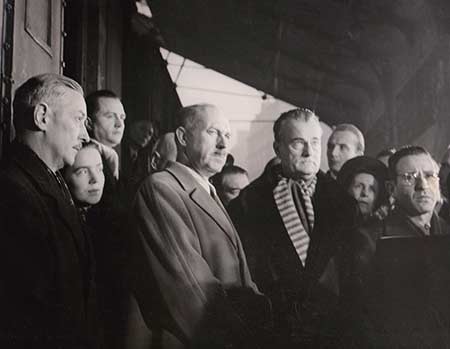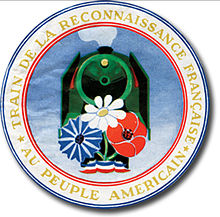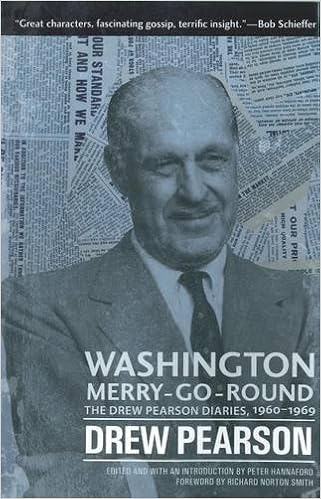
Communiqué du MDFDE :
Vous avez dit S O L I D A R I T É ? Lancement des projets #MDFDEJeSuisLadyLiberty131 et #MDFDEFriendshipTrainMerciTrain70 en célébration du 70ème Anniversaire de l’American Friendship Train (1947-2017) et du Merci Train français (1949-2019).

#GRATITUDE
#RESISTANCE
#MDFDEFriendshipMerciTrain70
© The Official French-American Project entirely conceived by Ms. Elisabeth JENSSEN to celebrate the 70th Anniversary of the Friendship Train and the Merci Train (2017- 2019). All rights reserved.
Chair, Elisabeth Jenssen
Honorary President: The Comte Gilbert de Pusy La Fayette
Contact: elisabeth.jenssen@francaisdeletranger.org
The Friendship Train featuring the Statue of Liberty
https://www.youtube.com/watch?v=pPS5-0QLJyE
https://www.youtube.com/watch?v=oWmYuvS7Aik
Friendship train begins trip to Europe
https://www.youtube.com/watch?v=Exkim70mUhs

L’emblème du Train de la reconnaissance française.
Chers membres du MDFDE, chers amis internautes,
Le 20 décembre 1947, il y a exactement 69 ans aujourd’hui, par la seule volonté d’un homme, Drew PEARSON, le célèbre journaliste d’investigation américain hautement controversé tout au long de sa carrière (voir sa présentation en anglais ci-dessous), arrivait à la Gare Saint-Lazare à Paris le “Friendship Train”, le “Train de l’Amitié”, un convoi d’aide alimentaire envoyé par 49 États des États-Unis dont la Californie, New York et Hawaii en signe de solidarité à la France – sa plus ancienne alliée grâce aux exploits de notre héroïque Marquis de La Fayette pendant la Guerre d’Indépendance américaine et pour lequel fut érigée la Statue de la Liberté – et à l’Europe dont l’Italie qui avait tout aussi faim, manquait de tout au lendemain de sa longue et brutale Deuxième Guerre mondiale.
Parti de Los Angeles, le 7 novembre 1947, avec seulement huit wagons de chemin de fer, ce projet humanitaire d’une grandeur exceptionnelle, peu connu de nos jours du grand public des deux côtés de l’Atlantique, remporta dans ses diverses escales à travers les États-Unis un succès si populaire qu’à son arrivée triomphale à New York, qui lui offrit une parade complète dans les rues de la ville le 18 novembre 1947, le convoi rassemblait au total plus de 700 wagons chargés de 16 000 précieuses tonnes de vivres, médicaments et vêtements collectés auprès de la population toute entière, des dons d’une valeur de 40 millions de dollars.
Et comme l’Histoire nous l’enseigne à chaque génération, une bonne action pouvant généralement en inspirer d’autres à faire de même… L’année suivante, la France voulant à son tour remercier les États-Unis de leur remarquable générosité, c’est sous le leadership d’André Picard, un vétéran et employé de la SNCF, soutenu par la Fédération Nationale des Anciens Combattants des Chemins de Fer de France et par l’Union française, que chaque ville et village se mobilisa, déclencha une opération citoyenne d’une ampleur jamais vue, jamais égalée à ce jour, donnant ainsi naissance à son propre Train de la reconnaissance française, son Merci Train, un convoi de 49 wagons de chemin de fer de la SNCF (dont la majorité existe toujours exposée dans divers lieux et parcs des États-Unis) surchargés de milliers de cadeaux des plus modestes aux plus riches partis de France par bateau vers New York et le reste des États-Unis acheminé par… chemin de fer (sauf bien sûr pour Hawaii) en 1949.
Fidèle aux traditions humanistes franco-américaines universelles… C’est dans cet esprit pionnier de solidarité, d’entraide, de coopération culturelle entre les peuples de bonne volonté que rien ni personne ne pourra jamais arrêter, que suite à notre projet #MDFDEJeSuisLadyLiberty130 réalisé entre Paris, New York et Seattle, cette année, comme vous le savez, et qui nous guidera jusqu’à l’ouverture, en 2019, sous le dynamique leadership de sa superbe marraine, Diane von Furstenberg, du nouveau Musée de la Statue de la Liberté à Liberty Island, New York. Qu’à cinq jours de Noël, le MDFDE se lance un nouveau défi, démarre son second spécial projet #MDFDEJeSuisLadyLiberty131 avec “antenne ferroviaire” #MDFDEFriendshipTrainMerciTrain70 en l’honneur du 70ème Anniversaire de lesdits Friendship Train (2017) et Merci Train (2019), une unique initiative ouverte également aux écoles françaises et américaines partenaires du MDFDE.
En ces temps d’incertitude collective, d’anxiété internationale face à l’adversité, le plus beau des cadeaux – une note d’espoir – que nous pouvons faire à nos enfants et petits-enfants passant par la transmission du savoir, du devoir de mémoire, le MDFDE et son propre expert en la matière, j’ai nommé mon ami Alexis Muller, vous invitent à nous rejoindre pour découvrir ensemble – de son inception en 1947… à sa conception en 1948… jusqu’à sa réalisation complète en 1949 – la fabuleuse histoire de nos Friendship Train et Merci Train.
En vous souhaitant à tous de bonnes fêtes de Noël et de fin d’année ainsi qu’à vos proches et amis. Ne baissons pas les bras ! Face aux difficultés qui nous attendent dès janvier, il n’y a pas de fatalité ! Tous à bord du Train de la Liberté et de l’Amitié “made in MDFDE” pour un voyage inoubliable dans le temps, au siècle dernier, à la mémoire de nos aînés qui ont résisté, dont certains ont payé de leur vie pour préserver nos chères libertés et la Paix ! Ne l’oublions jamais ! Tous soudés !
Fidèlement vôtre,
Elisabeth Jenssen Présidente-fondatrice
Le Mouvement des Français de l’Etranger (MDFDE) French & Francophones Abroad
Chair, MDFDE/Paris-NYC16 #MDFDEJeSuisLadyLiberty130-131
Links #MDFDEJeSuisLadyLiberty130:
Who was Drew Pearson?
 |
||
| Died September 1, 1969, Washington, D.C., United States Books The case against Congress Education Phillips Exeter Academy, Swarth College |
||
Andrew Russell “Drew” Pearson (December 13, 1897 – September 1, 1969) was one of the best-known American columnists of his day, noted for his syndicated newspaper column “Washington Merry-Go-Round,” in which he attacked various public persons. He also had a program on NBC Radio entitled Drew Pearson Comments.

Early life and career
Pearson was born in Evanston, Illinois; his parents were Paul Martin Pearson, an English professor at Northwestern University, and Edna Wolfe. When Pearson was 6 years of age, his father joined the faculty of Swarthmore College as professor of public speaking, and the family moved to Pennsylvania, joining the Society of Friends, with which the college was then affiliated. After being educated at Phillips Exeter Academy, Pearson attended Swarthmore (1915–19), where he edited its student newspaper, The Phoenix.

From 1919 to 1921, Pearson served with the American Friends Service Committee, directing postwar rebuilding operations in Pec, which at that time was part of Serbia. From 1921 to 1922, he lectured in geography at the University of Pennsylvania.

In 1923 Pearson traveled to Japan, China, New Zealand, Australia, India, and Serbia, and persuaded several newspapers to buy articles about his travels. He was also commissioned by the American “Around the World Syndicate” to produce a set of interviews entitled “Europe’s Twelve Greatest Men.”

From 1925 to 1928, Pearson continued reporting on international events, including strikes in China, the Geneva Naval Conference, the Pan-American Conference in Havana, and the signing of the Kellogg-Briand Pact in Paris.
In 1929 he became the Washington correspondent for The Baltimore Sun. However, in 1931 and 1932, with Robert S. Allen, he anonymously published a book called Washington Merry-Go-Round and its sequel. When the Sun discovered Pearson had co-authored these books, he was promptly fired. Late in 1932, Pearson and Allen secured a contract with the Scripps–Howard syndicate, United Features, to syndicate a column called “Washington Merry-Go-Round.” It first appeared in Eleanor “Cissy” Patterson’s Washington Herald on November 17, 1932. But as World War II escalated in Europe, Pearson’s strong support of Franklin D. Roosevelt, in opposition to Patterson and the Herald’s isolationist position, led to an acrimonious termination of Pearson’s and Allen’s contract with the Herald. In 1941 The Washington Post picked up the contract for the “Washington Merry-Go-Round.”
Radio, film, and other media
From 1935 to 1936, Allen and Pearson broadcast a 15-minute program twice a week on the Mutual Broadcasting System. They continued with a 30-minute music and news show, Listen America, in 1939–40, ending this partnership in 1941. They also wrote a comic strip, Hap Hopper, Washington Correspondent, which was drawn from 1939 to 1943 by Jack Sparling, and from 1943 onward by Al Plastino.
Pearson continued alone on NBC with Drew Pearson Comments from 1941 to 1953 for a variety of sponsors (Serutan, Nutrex, Lee Hats, Adam Hats). His commentary was broadcast through 1968 on the now-defunct Intermountain Network.
In addition to radio, Pearson appeared in a number of Hollywood movies, such as the 1951 science fiction film The Day the Earth Stood Still and RKO’s Betrayal from the East, a World War II propaganda movie. In the former film, Pearson (playing himself) is the only journalist who urges calm and restraint (versus the fear and paranoia evoked by his colleagues) while Washington is panicked by the escape of the alien visitor Klaatu. In the latter movie, Pearson narrated, in his “now it can be told” style, an alleged expose that accused Japanese Americans of being part of a Japanese conspiracy to engage in acts of terrorism and espionage. The movie was based on the 1943 best-selling book Betrayal from the East: The Inside Story of Japanese Spies in America by Alan Hynd. Pearson also appeared as himself in City Across the River (1949).
In 1952 and 1953, Pearson hosted The Drew Pearson Show on the ABC and DuMont networks.
On a January 8, 1950, broadcast of CBS Radio’s The Jack Benny Program. Pearson was the subject of a joke gone wrong. Announcer Don Wilson was to say he heard Jack bought a new suit on Drew Pearson, but said Pearson’s name wrong; Don said “Drear Pewson.” Later on in the show, comedic actor Frank Nelson was asked by Benny if he was the doorman. Changing the script, Nelson said, “Well who do you think I am … Drear Pewson?” The audience laughed for almost 30 seconds.
Washington Merry-Go-Round
The “Washington Merry-Go-Round” column started as a result of the anonymous publication in 1931 of the book, Washington Merry-Go-Round (New York: Horace Liveright and Co.), co-written with Robert S. Allen. The book was a collection of muckraking news items concerning key figures in public life that challenged the journalistic code of the day. In 1932 it was followed by a second book, More Merry-Go-Round. Pearson and Allen were successful enough in their books to become co-authors of the syndicated column, the “Washington Merry-Go-Round,” that same year. Also in 1932, the original book was made into a film of the same name by Columbia Pictures, directed by James Cruze, and starring Lee Tracy and Constance Cummings.
According to his one-time partner, Jack Anderson, Pearson saw journalism as a weapon to be used against those he judged to be working against the public interest. When forced to choose between a story’s accuracy and Pearson’s desire to pursue a person whose views he disliked, Pearson had no qualms about publishing the story anyway. In relating his disclosures on Washington politicians, newsmakers, and the politically connected, Pearson frequently resorted to a pattern of combining factual or corroborated leaked news items together with fabricated or unsubstantiated details, the latter designed to emphasize and sensationalize the basic story. Pearson’s method included paying waiters and chauffeurs to eavesdrop on their charges, gleaning information on politicians from political enemies, bribing a navy clerk to reveal classified data, or even ordering a subordinate to break into the desk of a prominent Washington attorney. A favorite Pearson tactic was to reveal salacious details of a subject’s sexual proclivities for the purpose of embarrassment or intimidation.
During World War II, Pearson’s column not only revealed embarrassing news items, but expanded to criticize the Roosevelt administration’s conduct of the war, in particular U.S. foreign policy regarding Joseph Stalin and the Soviet Union. As a supporter of the Soviet Union’s struggle against Nazi Germany, Pearson demanded that the Allied Command create a second front in Europe in 1943 to assist the Soviets. When Pearson’s demands were not met, he began to openly criticize Secretary of State Cordell Hull, James Dunn, and other State Department officials, whom Pearson accused of hating Soviet Russia. After one of Pearson’s more virulent columns accused Secretary of State Hull and his deputies of a conscious policy to “bleed Russia white,” President Roosevelt convened a press conference in which he angrily accused Pearson of printing statements that were a lie “from beginning to end”, jeopardizing United Nations unity, and committing an act of bad faith towards his own nation. The president concluded his statement by calling Pearson “a chronic liar.”
Pearson was the first to report the 1943 incident of General George S. Patton’s slapping of soldier Charles Kuhl. Pearson, whose reputation had been severely damaged after President Roosvelt had publicly called him a “chronic liar”, wanted to settle scores with the Roosevelt administration. Ernest Cuneo, a friend of Pearson and an official of the Office of Strategic Services, suggested to Pearson that a sensational, exclusive news story would make people forget Roosevelt’s criticism. Cuneo offered Pearson details of General George S. Patton’s slapping of a private soldier, Charles Kuhl, which he had learned from others in the War Department. In typical Pearson style, the columnist’s version of the slapping incident bore little relation to that of the actual event, conflated the details of two separate incidents involving Patton, and falsely claimed that General Patton would “not be used in important combat anymore.” Allied Headquarters denied that Patton had received either an official reprimand or a relief from combat duty, but confirmed that Patton had slapped a soldier with his gloves. Demands for Patton to be recalled and sent home soon arose in Congress as well as in newspaper articles and editorials across the country. However, public opinion was largely favorable to Patton. While Patton was later reassigned and his career advancement slowed, he was not relieved, but continued to serve in the European theater, where he would later command the famous U.S. Third Army. Pearson’s broadcast and subsequent article on Patton’s alleged behavior sufficiently raised the suspicions of Secretary of War Henry L. Stimson that he requested Army General Joseph T. McNarney to “put an inspector on the War Department to see who has been leaking out information. Pearson’s articles are about three-quarters false but there’s just a germ of truth in them that someone must have given him.”
After Pearson reported that General Douglas MacArthur was actively campaigning for his own promotion, MacArthur sued Pearson for defamation, but dropped the suit after Pearson threatened to publish love letters from MacArthur to his Eurasian paramour, Isabel Rosario Cooper.
In 1943 Pearson hired David Karr, a disgraced former employee of the Office of War Information as his chief aide. That year, a U.S. Civil Service Commission hearing had concluded that Karr was both untruthful and unreliable. Karr earned a reputation as an unscrupulous investigative reporter who misrepresented himself to sources. In 1944, Karr, a supporter of far left political causes and a former employee of the Communist newspaper The Daily Worker, became active in Vice President Henry Wallace’s effort to remain on the presidential ticket. Karr once obtained a confidential State Department report to President Roosevelt on Joseph Stalin by claiming to be on Vice President Wallace’s staff, and was the subject of two separate FBI espionage and loyalty investigations during the war.
In 1945, Pearson hired Jack Anderson for the staff of his column, the “Merry-Go-Round”.
Post-war activities
Following World War II, Pearson was largely responsible for the “Friendship Train” which raised over 40 million dollars in aid for war-torn Europe. On December 18, 1947 the much-needed food, medicine, and supplies arrived in France.
More: http://alchetron.com/Drew-Pearson-(journalist)-1310666-W
3 Comments, RSS